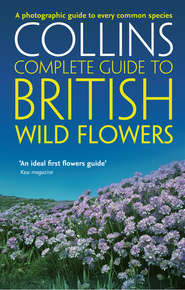
Полная версия:
British Wild Flowers: A photographic guide to every common species
Annual of arable land and disturbed ground. FLOWERS 6–8cm across with 4 papery, overlapping scarlet petals (often dark at the base); on slender stalks with spreading hairs (June–Aug). FRUITS Ovoid, flat-topped capsules. LEAVES Much divided into narrow segments. STATUS Widespread, commonest in S and E England; scarce in the north and west.

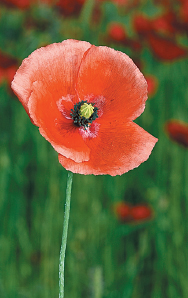
Long-headed Poppy

Fruit
Long-headed Poppy Papaver dubium (Papaveraceae) HEIGHT to 60cm
Annual of arable land and disturbed ground. FLOWERS 3–7cm across with 4 papery, orange-red overlapping petals with no dark basal blotch; on stalks with appressed hairs (June–Aug). FRUITS Narrow, elongated, hairless capsules. LEAVES Much divided into narrow segments. STATUS Widespread and fairly common, including the north.


Rough Poppy

Rough Poppy

Fruit
Rough Poppy Papaver hybridum (Papaveraceae)

Hairy annual of arable fields, mainly on calcareous soils. FLOWERS 2–5cm across with 4 crimson, overlapping petals with dark-blotched bases; on hairy stalks (June–Aug). FRUITS Ovoid to spherical with spreading, yellowish hairs. LEAVES Much divided and bristle-tipped. STATUS Scarce and declining, mainly in S England.

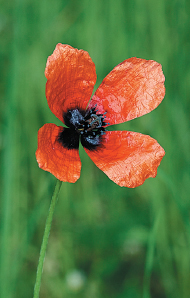
Prickly Poppy

Fruit
Prickly Poppy Papaver argemone (Papaveraceae)

Delicate annual of arable land, mainly on sandy soils. FLOWERS 2–6cm across with 4 pale red petals that typically do not overlap but which do have a dark basal blotch (May–Aug). FRUITS Narrow, elongated and ribbed with prickle-like bristles. LEAVES Much divided; bristle-tipped. STATUS Local and scarce, mainly in S England.



Poppy, Barberry and Cabbage Families

Yellow Horned-poppy
Yellow Horned-poppy Glaucium flavum (Papaveraceae)

Blue-grey, clump-forming perennial of shingle beaches. FLOWERS 5–7cm across with overlapping yellow petals (June–Sep). FRUITS Elongated, curved capsules, to 30cm long. LEAVES Pinnately divided, the clasping upper ones having shallow, toothed lobes. STATUS Locally common on most suitable coasts except far N.

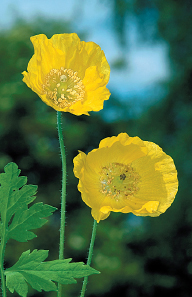
Welsh Poppy
Welsh Poppy Meconopsis cambrica (Papaveraceae)

Showy perennial of shady woods. FLOWERS 4–6cm across with 4 overlapping, bright yellow petals; on slender stems (June–Aug). FRUITS 4-to 6-ribbed capsules that split when ripe. LEAVES Pinnately divided, toothed, stalked. STATUS Native to Wales, SW England and Ireland; naturalised as a garden escape elsewhere.



Greater Celandine
Greater Celandine Chelidonium majus (Papaveraceae) HEIGHT to 80cm
Tall, brittle-stemmed perennial. Found in hedgerows and along woodland rides. FLOWERS 2–3cm across and comprising 4 non-overlapping bright yellow petals (Apr–Oct). FRUITS Narrow capsules that split from below when ripe. LEAVES Grey-green, pinnately divided. STATUS Native but also naturalised.


Fruit

Barberry
Barberry Berberis vulgaris (Berberidaceae)

Small, deciduous shrub with grooved twigs and 3-forked prickles. Found in hedgerows and scrub, mainly on calcareous soils. FLOWERS Small, yellow; in hanging clusters (May–June). FRUITS Ovoid, reddish berries. LEAVES Sharp-toothed, oval; borne in tufts from axils of prickles. STATUS Scarce native; also naturalised.


Bush, Robin
Tall Rocket
Tall Rocket Sisymbrium altissimum (Brassicaceae)

Upright annual of waste ground; hairless above but hairy below. FLOWERS 1cm across, yellow petals, twice the length of sepals (June–Aug). FRUITS Slender, narrow and up to 10cm long. LEAVES Have very narrow lobes. STATUS Introduced but established in S and E England. Eastern Rocket S. orientale is similar but with smaller flowers and divided leaves that are spear-shaped overall. Waste ground, in S.


Bush, Robin
False London-rocket
False London-rocket Sisymbrium loeselii (Brassicaceae)

Straggly, upright annual with bristly hairy lower stems. Found on waste ground. FLOWERS 4–6mm across, with 4 yellow petals twice as long as the sepals (June– Aug). FRUITS Pods 2–4cm long that do not overtop the flowers. LEAVES Deeply pinnately lobed. STATUS Casual in S; sometimes naturalised, mainly in London. London Rocket S. irio is similar but hairless. Petals equal to, or slightly longer than, sepals (Jun–Aug); slender pods overtop flowers. Wasteground, mainly London and Dublin.


Hedge Mustard

Hedge Mustard
Hedge Mustard Sisymbrium officinale (Brassicaceae) HEIGHT to 90cm
Tough, upright annual or biennial of waste ground and disturbed soil. FLOWERS 3mm across with 4 yellow petals; in terminal clusters (May–Oct). FRUITS Cylindrical, 1–2cm long, pressed close to the stem. LEAVES Variable: lower leaves deeply divided, stem leaves narrow. STATUS Widespread and common throughout.


Flixweed
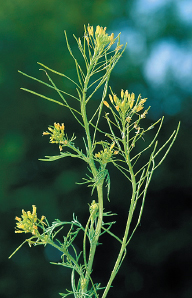
Flixweed
Flixweed Descurainia sophia (Brassicaceae)

Much-divided, bushy, hairy annual found on waste and bare ground, usually on sandy soils. FLOWERS 3mm across, with 4 pale yellow petals equal to the sepals; in terminal clusters (June–Aug). FRUITS Slender, cylindrical pods up to 4cm long. LEAVES Grey-green, finely divided. STATUS Widespread but distinctly local.


Bush, Robin
Treacle-mustard
Treacle-mustard Erysimum cheiranthoides (Brassicaceae)

Slender, upright annual with angled stems. Found on waste ground and arable field margins. FLOWERS 6–10mm across, with 4 yellow petals longer than the sepals; in terminal clusters (June–Sep). FRUITS 25mm long, slender. LEAVES Shallowly lobed, narrow. STATUS Introduced and naturalised.

Cabbage Family Brassicaceae
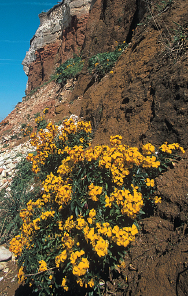
Janes, Ernie
Wallflower
Wallflower Erysimum cheiri HEIGHT to 60cm
Showy perennial with a woody-based stem and branched hairs. Associated with cliffs and old walls. FLOWERS 2–3cm across with 4 orange-yellow petals; in terminal clusters (Mar–June). FRUITS Flattened, 7cm long. LEAVES Narrow, untoothed. STATUS Widely naturalised as a garden escape.


Burbidge, Brinsley
Dame’s-violet
Dame’s-violet Hesperis matronalis

Hairy biennial or perennial associated with hedgerows and wayside places. FLOWERS Fragrant, 17–20mm across, with 4 violet or pinkish-white petals; in terminal clusters (May–Aug). FRUITS Long, flattened, curving upwards. LEAVES Narrow, pointed, untoothed, stalked. STATUS Widely naturalised as a garden escape.

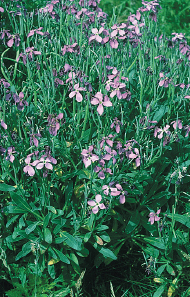
Hall, Jean
Hoary Stock
Hoary Stock Matthiola incana

Downy, greyish annual or perennial with a woody-based stem. Associated with sea cliffs. FLOWERS Fragrant, 25–30mm across, with 4 white to purple petals (Apr–July). FRUITS Cylindrical pods to 13cm long. LEAVES Narrow, untoothed. STATUS Scarce and doubtfully native although possibly so in S England and S Wales.

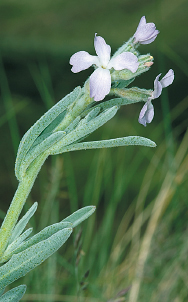
Sea Stock
Sea Stock Matthiola sinuata

Downy, grey-green perennial, the base of which is not woody. Associated with coastal dunes and sea cliffs. FLOWERS Fragrant, 25–30mm across, with 4 pinkish petals (June–Aug). FRUITS Narrow, elongated pods. LEAVES Narrow, with toothed or lobed margins. STATUS Rare; SW England, S Wales, S Ireland and Channel Islands only.


Winter-cress
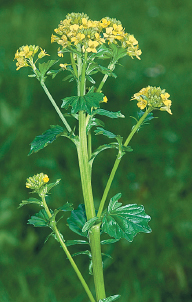
Winter-cress
Winter-cress Barbarea vulgaris HEIGHT to 80cm
Upright, hairless perennial of damp ground. FLOWERS 7–9mm across with 4 yellow petals; in terminal heads (May–Aug). FRUITS Long, narrow, 4-sided pods. LEAVES Dark green, shiny; lower ones divided, the end lobe large and oval; upper stem leaves entire. STATUS Widespread but commonest in the south.

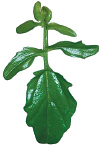
Medium-flowered Winter-cress
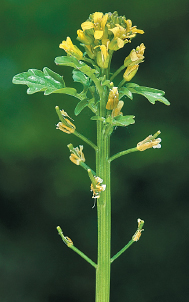
Medium-flowered Winter-cress
Medium-flowered Winter-cress Barbarea intermedia

Upright, hairless perennial of waste ground. FLOWERS 5–6mm across with 4 yellow petals; in terminal heads (Mar–Aug). FRUITS Long, narrow, 4-sided pods. LEAVES Dark green, shiny; all lobed. STATUS Introduced, occasional but seemingly increasing.


Marsh Yellow-cress

Marsh Yellow-cress
Marsh Yellow-cress Rorippa palustris HEIGHT to 50cm
Annual of damp, marshy hollows, sometimes growing in shallow water. Stems upright, angular, hollow. FLOWERS 3mm across with 4 yellow petals equal in length to sepals; in terminal heads (June–Oct). FRUITS Elliptical pods, 4–6mm long. LEAVES Pinnately lobed. STATUS Locally common throughout, except in the north.


Creeping Yellow-cress
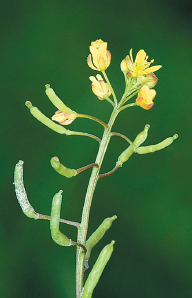
Creeping Yellow-cress
Creeping Yellow-cress Rorippa sylvestris

Sprawling annual of damp, bare ground, with solid, not hollow, stems. FLOWERS 5mm across with 4 yellow petals twice as long as sepals; in terminal heads (June–Oct). FRUITS Elliptical pods, 8–15mm long. LEAVES Pinnately lobed. STATUS Locally common in England and Wales; scarce elsewhere.


Great Yellow-cress
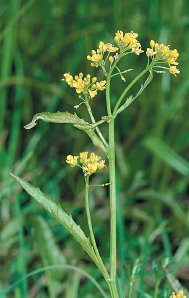
Great Yellow-cress
Great Yellow-cress Rorippa amphibia

Robust, hairless perennial with stout, hollow stems. Favours damp ground and the margins of freshwater habitats. FLOWERS 5–7mm across with 4 yellow petals twice as long as sepals; in terminal heads (June–Sep). FRUITS Elliptical pods, 3–6mm long. LEAVES Shallowly lobed. STATUS Locally common in south but absent from north.


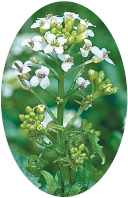
Water-cress
Water-cress Rorippa nasturtium-aquaticum HEIGHT to 15cm
Usually creeping perennial of shallow streams and ditches. FLOWERS 4–6mm across with 4 white petals; in terminal heads (May–Oct). FRUITS Narrow pods, 16–18mm long, containing 2 rows of seeds. LEAVES Dark green and pinnately divided; persisting through winter. STATUS Widespread and common; widely cultivated in S England.


Hairy Bitter-cress

Hairy Bitter-cress
Hairy Bitter-cress Cardamine hirsuta HEIGHT to 30cm
Upright annual with hairless stems. Found on damp, disturbed ground. FLOWERS 2–3mm across (petals sometimes absent) and terminal (Feb–Nov). FRUITS Curved, up to 2.5cm long, overtopping flowers. LEAVES Pinnately divided with rounded lobes; seen mainly as a basal rosette plus 1–4 stem leaves. STATUS Widespread and common.


Wavy Bitter-cress

Wavy Bitter-cress



